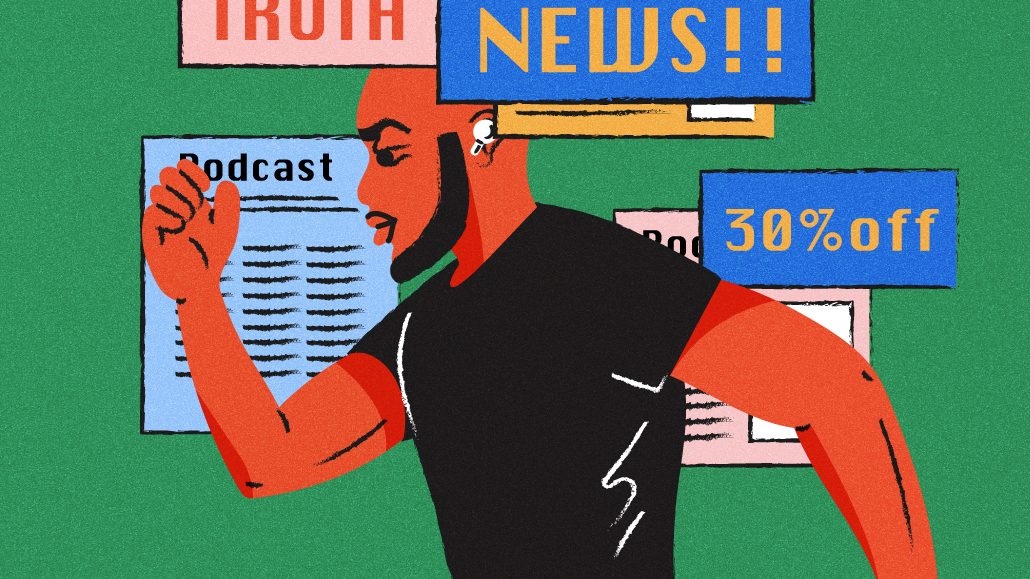
On Monday, The Washington Post added AI-generated audio to its three politics- and policy-focused newsletters to give readers the ability to listen to those emails.
Solventum and PhRMA are launch sponsors for the newsletters this week, which will also contain AI-generated audio ads for the first time. Each audio newsletter edition will have pre- and post-roll audio ads inserted dynamically each day.
The audio versions of the newsletters are available by clicking through from the emailed newsletters to The Post’s site — but the focus for the initiative is the experience of listening to the audio in the Listen tab in The Washington Post’s app, which debuted last November, said Renita Jablonski, The Post’s director of audio. The tab allows users to create a playlist of audio offerings from The Post, such as podcasts, morning briefings and other articles.
Jablonski said The Post has 4 million audio starts on its owned and operated platforms on a given 30-day average, with almost 90% of those originating from its app — the majority of which are audio articles. The publisher’s average daily audio listens have doubled since the end of last year, a spokesperson said.
Seventy percent of audio users are listening to Post journalism from start to finish, and about one-third of subscribers listen to The Post’s audio content in the app two or more days a week, they added. (The Post also launched a subscriber-only podcast feed in Apple Podcasts in January, which includes curated audio articles.)
Previously branded under the name “202,” the three politics and policy newsletters were renamed to “The Early Brief,” “The Tech Brief” and “The Health Brief” this week. The briefings are a mix of daily news analysis, written commentary and curated news headlines. The Early and Health Briefs publish every weekday, while the Tech Brief goes out three times a week. The newsletters are free to read (and listen to). The Post declined to share how many subscribers the newsletters have.
Large news organizations like The Post and The New York Times are using AI technology to generate audio versions of text content. Jablonski said most of The Post’s content is available in audio formats (either from AI-generated voices or authors reading narrative reporting or opinion pieces, for example — content like recipes, however, don’t get audio versions).
The AI-generated audio versions of the newsletters are created using the same technology that’s used to convert The Post’s articles, thanks to a partnership with AI voice generating software company Eleven Labs. Jablonski said several Post teams collaborate to quality check the audio — she meets with media engineering and product colleagues herself, for example.
In The New York Times Company’s Q1 2024 earnings call on May 8, CEO Meredith Kopit Levien said the company was “experimenting more ambitiously with audio by introducing the ability to listen to much of our report by an AI-powered automated voice.”
For The Washington Post, these aren’t the first newsletters to get the audio treatment. The Post’s short daily briefing “The 7,” debuted in 2021 with an AI-audio version that evolved into a human-hosted podcast a year later.
But is there an audience for this? Jablonski said the audio versions are helpful for people who don’t have time to finish reading the newsletters, and want to continue consuming them while on the go.
Ultimately, the benefit of AI-generated audio is the speed at which it can be created, Jablonski said.
“What’s so interesting is the speed component. … If there is breaking news, you’re going to be able to listen to that immediately because of this technology. [Otherwise] it would take time to record somebody, to clean up any errors, to produce the mix of that. So that is a big piece of it,” she said.
Glenn Rubenstein, CEO and founder of podcast ad agency Adopter Media, said having reporting read aloud is a “very nice convenience.” AI tech companies like OpenAI are adding more voice and conversational language to their products, as seen in the GPT-4o model demo last week.
“Whether it’s a human or AI — it’s certainly no stranger than watching a video [on social media] and reading the subtitles instead of listening. We are living in a world of consuming content on your own terms,” Rubenstein said.
However, he wasn’t convinced this specific move by The Post would attract more ad dollars to its newsletters.
“I think it’s a bell and whistle but I don’t think it’s going to get anybody to buy anything they’re not already buying,” Rubenstein said. “The lower effort and lower touch an ad is, the worse it performs.” Adopter is not buying AI-generated audio ads, mostly due to quality issues, Rubinstein noted.
The AI-read audio ads from the Briefs’ launch sponsors are part of a larger sponsorship bundle that also includes multiple display and print ads, The Post spokesperson said. The success of the ads will be measured through KPIs such as ad listen-through rates and content completion rates, they added.
“I wouldn’t pay extra for this as an agency or as an advertiser. If it’s offered as a value-added bonus, great,” Rubenstein said.
More in Media

From sidelines to spotlight: Esports events are putting creators center stage
Esports events’ embrace of content creators reflects advertisers’ changing priorities across both gaming and the wider culture. In the past, marketers viewed esports as one of the best ways to reach gamers. In 2025, brands are instead prioritizing creators in their outreach to audiences across demographics and interest areas, including gaming.

Condé Nast and Hearst strike Amazon AI licensing deals for Rufus
Condé Nast and Hearst have joined the New York Times in signing a licensing deal with Amazon for its AI-powered shopping assistant Rufus.

Media Briefing: AI payouts may be entering a new era
AI compensation is evolving — and new models, not just publisher demands, are driving the shift beyond flat-fee licensing.






